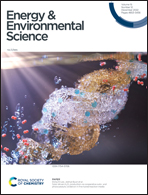Performance limitations imposed by the TCO heterojunction in high efficiency perovskite solar cells†
Abstract
The power conversion efficiency of perovskite solar cells (PSCs) has risen rapidly, but continuing this trend requires a clear view of all possible sources of power loss. Over the past decade in which we have witnessed these remarkable improvements, the transparent conductive oxide (TCO) has been widely treated as an extrinsic element. While it is recognised that the TCO contributes power loss due to finite lateral resistance and optical losses, comparatively little attention has been paid to the influence of the TCO on the electrostatics in other cell layers. However, a recent fill factor (FF) record on a centimetre-scale PSC has refocused attention on how the TCO can play a significant role in the optoelectronic properties across the entire TCO-transport layer-perovskite interface. Primarily, this is the consequence of the Schottky-type heterojunction formed between the TL and TCO layers, which establishes a space-charge region within the TL. Due to the extreme thinness of many TL layers, the space charge region can extend the full width of the TL and even into the perovskite layer itself. In effect, the bulk properties of the TL come to be dominated by the equilibrium conditions of this junction, with the consequence that the TL can be markedly less conductive once in situ within a PSC. This in situ resistance can significantly reduce FF, but without knowledge of this mechanism, the source of resistance and FF loss would be non-obvious. In this contribution, we employ ionic–electronic device models to quantify the TCO-induced in situ conductance of the transport layer and demonstrate its characteristic appearance in the JV curves of high-performance PSCs. We posit that widely used titanium dioxide (TiO2) can be particularly susceptible to a low in situ conductance, which explains the years-long plateau of FFs in TiO2-based PSCs in the low 80%-range. By comparison to inverted PSCs, we illustrate how the TCO influence can explain comparative underperformance of FF relative to open-circuit voltage and photocurrent in state-of-the-art n–i–p PSCs. We hope that by refocusing attention on this factor of PSC design, this work can provide a facile path to plausibly lifting single junction PSCs beyond 26% efficiency.



 Please wait while we load your content...
Please wait while we load your content...